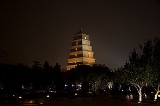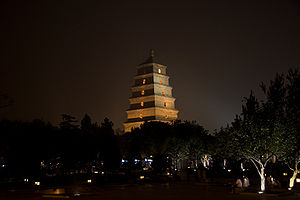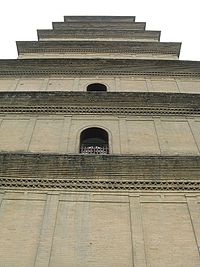
Giant Wild Goose Pagoda
Encyclopedia

Chinese pagoda
Chinese Pagodas are a traditional part of Chinese architecture. In addition to religious use, since ancient times Chinese pagodas have been praised for the spectacular views which they offer, and many famous poems in Chinese history attest to the joy of scaling pagodas.-History:The pagoda is...
located in southern Xi'an
Xi'an
Xi'an is the capital of the Shaanxi province, and a sub-provincial city in the People's Republic of China. One of the oldest cities in China, with more than 3,100 years of history, the city was known as Chang'an before the Ming Dynasty...
, Shaanxi
Shaanxi
' is a province in the central part of Mainland China, and it includes portions of the Loess Plateau on the middle reaches of the Yellow River in addition to the Qinling Mountains across the southern part of this province...
province, China
People's Republic of China
China , officially the People's Republic of China , is the most populous country in the world, with over 1.3 billion citizens. Located in East Asia, the country covers approximately 9.6 million square kilometres...
. It was built in 652
652
Year 652 was a leap year starting on Sunday of the Julian calendar. The denomination 652 for this year has been used since the early medieval period, when the Anno Domini calendar era became the prevalent method in Europe for naming years.- Africa :* Second Battle of Dongola between Makuria and...
during the Tang Dynasty
Tang Dynasty
The Tang Dynasty was an imperial dynasty of China preceded by the Sui Dynasty and followed by the Five Dynasties and Ten Kingdoms Period. It was founded by the Li family, who seized power during the decline and collapse of the Sui Empire...
and originally had five stories, although the structure was rebuilt in 704 during the reign of Empress Wu Zetian
Wu Zetian
Wu Zetian , personal name Wu Zhao , often referred to as Tian Hou during the Tang Dynasty and Empress Consort Wu in later times, was the only woman in the history of China to assume the title of Empress Regnant...
and its exterior brick facade was renovated during the Ming Dynasty
Ming Dynasty
The Ming Dynasty, also Empire of the Great Ming, was the ruling dynasty of China from 1368 to 1644, following the collapse of the Mongol-led Yuan Dynasty. The Ming, "one of the greatest eras of orderly government and social stability in human history", was the last dynasty in China ruled by ethnic...
. One of the pagoda's many functions was to hold sutra
Sutra
Sūtra is an aphorism or a collection of such aphorisms in the form of a manual. Literally it means a thread or line that holds things together and is derived from the verbal root siv-, meaning to sew , as does the medical term...
s and figurine
Figurine
A figurine is a statuette that represents a human, deity or animal. Figurines may be realistic or iconic, depending on the skill and intention of the creator. The earliest were made of stone or clay...
s of the Buddha
Gautama Buddha
Siddhārtha Gautama was a spiritual teacher from the Indian subcontinent, on whose teachings Buddhism was founded. In most Buddhist traditions, he is regarded as the Supreme Buddha Siddhārtha Gautama (Sanskrit: सिद्धार्थ गौतम; Pali: Siddhattha Gotama) was a spiritual teacher from the Indian...
that were brought to China from India
India
India , officially the Republic of India , is a country in South Asia. It is the seventh-largest country by geographical area, the second-most populous country with over 1.2 billion people, and the most populous democracy in the world...
by the Buddhist translator and traveler Xuanzang
Xuanzang
Xuanzang was a famous Chinese Buddhist monk, scholar, traveler, and translator who described the interaction between China and India in the early Tang period...
.
Surroundings and history


Emperor Gaozong of Tang
Emperor Gaozong of Tang , personal name Li Zhi , was the third emperor of the Tang Dynasty in China, ruling from 649 to 683...
(r. 649-683), then standing at a height of 54 m (177 ft). However, this construction of rammed earth
Rammed earth
Rammed earth, also known as taipa , tapial , and pisé , is a technique for building walls using the raw materials of earth, chalk, lime and gravel. It is an ancient building method that has seen a revival in recent years as people seek more sustainable building materials and natural building methods...
with a stone exterior facade eventually collapsed five decades later. The ruling Empress Wu Zetian
Empress Wu
Empress Wu may mean or refer to:* Empress Wu , the wife of Liu Bei, the first emperor of Shu Han* Empress Wu, a title name for Wu Zetian* Consort Wu , Wu Zetian's grandniece, who was posthumously honored as an empress...
had the pagoda rebuilt and added five new stories by the year 704 AD. However, a massive earthquake in 1556 heavily damaged the pagoda and reduced it by three stories, to its current height of seven stories. The entire structure leans very perceptibly (several degrees) to the west. Its related structure, the 8th century Small Wild Goose Pagoda
Small Wild Goose Pagoda
The Small Wild Goose Pagoda, sometimes Little Wild Goose Pagoda , is one of two significant pagodas in the city of Xi'an, China, the site of the old Han and Tang capital Chang'an. The other notable pagoda is the Giant Wild Goose Pagoda, originally built in 652 and restored in 704...
in Xi'an, only suffered minor damage in the 1556 earthquake (still unrepaired to this day). The Giant Wild Goose Pagoda was extensively repaired during the Ming Dynasty
Ming Dynasty
The Ming Dynasty, also Empire of the Great Ming, was the ruling dynasty of China from 1368 to 1644, following the collapse of the Mongol-led Yuan Dynasty. The Ming, "one of the greatest eras of orderly government and social stability in human history", was the last dynasty in China ruled by ethnic...
(1368–1644) and renovated again in 1964. The pagoda currently stands at a height of 64 m (210 ft) tall and from the top it offers views over the current city of Xi'an.
During the Tang Dynasty the pagoda was located within the grounds of a monastery, within a walled ward of the larger southeastern sector of the city, then known as Chang'an. The monastic grounds around the pagoda during the Tang Dynasty had ten courtyards and a total of 1,897 bays. In those days graduate students of the Advanced Scholars examination
Imperial examination
The Imperial examination was an examination system in Imperial China designed to select the best administrative officials for the state's bureaucracy. This system had a huge influence on both society and culture in Imperial China and was directly responsible for the creation of a class of...
in Chang'an inscribed their names at this monastery.
Close by the pagoda is the Temple of Great Maternal Grace; Da Ci'en. This temple was originally built in AD 589
589
Year 589 was a common year starting on Saturday of the Julian calendar. The denomination 589 for this year has been used since the early medieval period, when the Anno Domini calendar era became the prevalent method in Europe for naming years.- Europe :* October 17 – The Adige River...
and then rebuilt AD 647
647
Year 647 was a common year starting on Monday of the Julian calendar. The denomination 647 for this year has been used since the early medieval period, when the Anno Domini calendar era became the prevalent method in Europe for naming years.- Asia :* A stone tower astronomical observatory named...
in memory of his mother Empress Wende by Li Zhi who later became the Tang Emperor Gaozong.
The monk Xuanzang
Xuanzang
Xuanzang was a famous Chinese Buddhist monk, scholar, traveler, and translator who described the interaction between China and India in the early Tang period...
's statue stands in front of the temple area.
See also
- Monk XuanzangXuanzangXuanzang was a famous Chinese Buddhist monk, scholar, traveler, and translator who described the interaction between China and India in the early Tang period...
- Small Wild Goose PagodaSmall Wild Goose PagodaThe Small Wild Goose Pagoda, sometimes Little Wild Goose Pagoda , is one of two significant pagodas in the city of Xi'an, China, the site of the old Han and Tang capital Chang'an. The other notable pagoda is the Giant Wild Goose Pagoda, originally built in 652 and restored in 704...
- Chinese pagodaChinese pagodaChinese Pagodas are a traditional part of Chinese architecture. In addition to religious use, since ancient times Chinese pagodas have been praised for the spectacular views which they offer, and many famous poems in Chinese history attest to the joy of scaling pagodas.-History:The pagoda is...
- Chinese architectureChinese architectureChinese architecture refers to a style of architecture that has taken shape in East Asia over many centuries. The structural principles of Chinese architecture have remained largely unchanged, the main changes being only the decorative details...
- Three PagodasThree PagodasThe Three Pagodas are an ensemble of three independent pagodas arranged on the corners of a equilateral triangle, near the town of Dali, Yunnan province, China, dating from the time of the Nanzhao kingdom and Kingdom of Dali....

